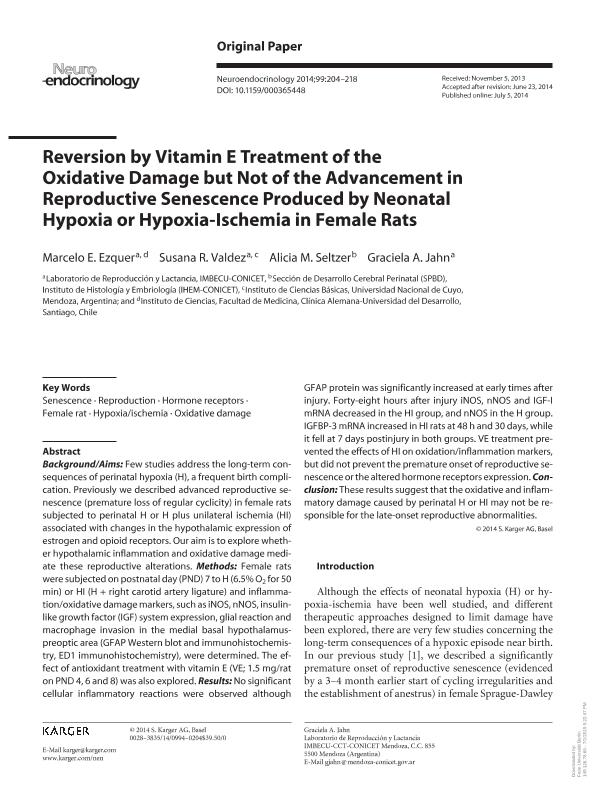Mostrar el registro sencillo del ítem
dc.contributor.author
Ezquer, Eduardo Marcelo

dc.contributor.author
Valdez, Susana Ruth

dc.contributor.author
Seltzer, Alicia Mabel

dc.contributor.author
Jahn, Graciela Alma

dc.date.available
2020-06-10T17:36:01Z
dc.date.issued
2014-07
dc.identifier.citation
Ezquer, Eduardo Marcelo; Valdez, Susana Ruth; Seltzer, Alicia Mabel; Jahn, Graciela Alma; Reversion by Vitamin E treatment of the oxidative damage but not of the advancement in reproductive senescence produced by neonatal hypoxia or hypoxia-ischemia in female rats; Karger; Neuroendocrinology; 99; 3-4; 7-2014; 204-218
dc.identifier.issn
0028-3835
dc.identifier.uri
http://hdl.handle.net/11336/107194
dc.description.abstract
Background/Aims: Few studies address the long-term consequences of perinatal hypoxia, a frequent birth complication. Previously we described advanced reproductive senescence (premature loss of regular cyclicity) in female rats subjected to perinatal hypoxia (H) or hypoxia plus unilateral ischemia (HI) associated with changes in hypothalamic expression of estrogen and opioid receptors. Our aim is to explore whether hypothalamic inflammation and oxidative damage mediate these reproductive alterations.Methods: Female rats were subjected on post-natal day (PND) 7 to H (6.5 % O2 for 50 min) or HI (H + right carotid artery ligature) and inflammation/oxidative damage markers such as iNOS, nNOS, IGF system expression, glial reaction and macrophage invasion in the medial basal hypothalamus-preoptic area (GFAP Western blot and immunohistochemistry, ED1 immunohistochemistry) were determined. The effect of antioxidant treatment with vitamin E (VE, 1.5 mg/rat on PND4, 6 and 8) was also explored. Results: No significant cellular inflammatory reactions were observed although GFAP protein was significantly increased at early times after injury. 48 h after injury iNOS, nNOS and IGF-I mRNA decreased in the HI group and nNOS in the H group. IGFBP-3 mRNA increased in HI rats at 48 h and 30 days, while it fell at 7 days post-injury in both groups. VE treatment prevented the effects of HI on oxidation/inflammation markers, but did not prevent the premature onset of reproductive senescence or the altered hormone receptors expression. Conclusion: these results suggest that the oxidative and inflammatory damage caused by perinatal H or HI may not be responsible for the late-onset reproductive abnormalities.
dc.format
application/pdf
dc.language.iso
eng
dc.publisher
Karger

dc.rights
info:eu-repo/semantics/openAccess
dc.rights.uri
https://creativecommons.org/licenses/by-nc-sa/2.5/ar/
dc.subject
senescence
dc.subject
reproduction
dc.subject
female rat
dc.subject
hypoxia/ischemia
dc.subject
oxidative damage
dc.subject
hormone receptors
dc.subject.classification
Neurociencias

dc.subject.classification
Medicina Básica

dc.subject.classification
CIENCIAS MÉDICAS Y DE LA SALUD

dc.subject.classification
Biología Reproductiva

dc.subject.classification
Ciencias Biológicas

dc.subject.classification
CIENCIAS NATURALES Y EXACTAS

dc.title
Reversion by Vitamin E treatment of the oxidative damage but not of the advancement in reproductive senescence produced by neonatal hypoxia or hypoxia-ischemia in female rats
dc.type
info:eu-repo/semantics/article
dc.type
info:ar-repo/semantics/artículo
dc.type
info:eu-repo/semantics/publishedVersion
dc.date.updated
2020-05-11T15:39:25Z
dc.journal.volume
99
dc.journal.number
3-4
dc.journal.pagination
204-218
dc.journal.pais
Suiza

dc.journal.ciudad
Basel
dc.description.fil
Fil: Ezquer, Eduardo Marcelo. Consejo Nacional de Investigaciones Científicas y Técnicas. Centro Científico Tecnológico Conicet - Mendoza. Instituto de Medicina y Biología Experimental de Cuyo; Argentina. Universidad del Desarrollo. Facultad de Medicina Clínica Alemana; Chile
dc.description.fil
Fil: Valdez, Susana Ruth. Consejo Nacional de Investigaciones Científicas y Técnicas. Centro Científico Tecnológico Conicet - Mendoza. Instituto de Medicina y Biología Experimental de Cuyo; Argentina. Universidad Nacional de Cuyo. Facultad de Ciencias Exactas y Naturales; Argentina
dc.description.fil
Fil: Seltzer, Alicia Mabel. Universidad Catolica de Cuyo. Facultad de Ciencias Medicas. Departamento de Histologia y Biologia.; Argentina. Consejo Nacional de Investigaciones Científicas y Técnicas. Centro Científico Tecnológico Conicet - Mendoza; Argentina
dc.description.fil
Fil: Jahn, Graciela Alma. Consejo Nacional de Investigaciones Científicas y Técnicas. Centro Científico Tecnológico Conicet - Mendoza. Instituto de Medicina y Biología Experimental de Cuyo; Argentina
dc.journal.title
Neuroendocrinology

dc.relation.alternativeid
info:eu-repo/semantics/altIdentifier/doi/https://doi.org/10.1159/000365448
dc.relation.alternativeid
info:eu-repo/semantics/altIdentifier/url/https://www.karger.com/Article/Abstract/365448
Archivos asociados
